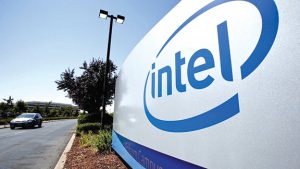Bloomberg
Brookfield Infrastructure Partners LP’s $15 billion commitment last year to help finance Intel Corp.’s giant new semiconductor complex in Arizona, the first deal of its kind, sent investors and bankers racing to find similar opportunities.
Brookfield, a major infrastructure investor, put up $2 billion in equity and borrowed $13 billion from a mix of foreign banks, pension funds and sovereign wealth funds, ¬according to people familiar with the matter, who asked not to be identified because the details weren’t public. That model isn’t new to infrastructure assets, just to semiconductors, says Scott Peak, Brookfield Infrastructure’s chief investment officer for North America.
For Intel, bringing in a deep-pocketed investor to cover 49% of the plant’s cost helps to support finances stretched by an ¬unprecedented expansion plan, a tough competitive landscape and a steep industrywide downturn. (In late January the chipmaker gave one of its gloomiest forecasts ever, sending shares tumbling.) When the deal was announced in August, Intel described Brookfield’s rate of return as “somewhere between its cost of debt and equity,†which it pegged between about 4% and 8.5%. Intel declined to provide more details.
How the investment plays out will demonstrate whether private equity firms and their growing infrastructure funds can be part of the plan to reassert US competitiveness in chip manufacturing. Governments in North America and Europe are trying to rebuild that strategic capability and reduce their reliance on plants in East Asia. Brookfield’s Peak estimates that $1 trillion of capital is required for what Brookfield considers “large-scale critical manu¬facturing†in areas such as semiconductors, aerospace, auto and gigafactories, data management and telecommunications.
“There are a lot of infrastructure categories that are well-¬established that were not on an investor’s radar 5 or 10 years ago—think data centers, towers and fiber,†Peak says. “New asset classes evolve, and with them come new models and contractual arrangements that attract the right investor base.â€
The growing need for semiconductors and the high valuations of companies such as Taiwan Semiconductor Manufacturing Co. have attracted interest from investors. Firms including KKR & Co. and Blackstone Inc. have raised war chests to invest in the space as the definition of infrastructure stretches beyond toll roads and ports to data centers, cellphone towers and fiber networks. In December, AT&T Corp. and a unit of BlackRock Inc. announced plans to form a joint venture that will provide internet service to US customers outside AT&T’s traditional 21-state local phone territory.
Intel, which named the new funding model SCIP (sounds like “skipâ€), for semiconductor co-investment program, is already being contacted by investors with access to pools of private capital looking to form partnerships on other fabrication plants, known as fabs, in Ohio and Germany, according to people familiar with the matter. Intel Chief Executive Officer Pat Gelsinger said in January that the company expects to create a second SCIP this year.
 The Gulf Time Newspaper One of the finest business newspapers in the UAE brought to you by our professional writers and editors.
The Gulf Time Newspaper One of the finest business newspapers in the UAE brought to you by our professional writers and editors.
